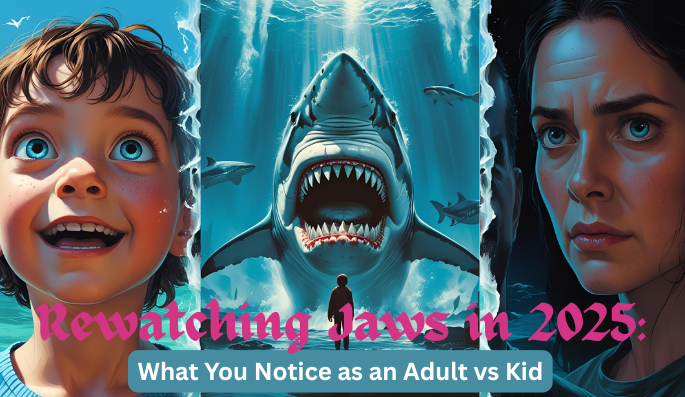Everyone remembers their first time watching Jaws. The suspense. The music. The horror of never looking at the ocean the same way again. But if you’ve revisited Jaws recently—as an adult, in 2025—you probably noticed something surprising:
It’s a completely different movie than you remember as a kid.
Sure, the shark is still terrifying, and that John Williams score still sends shivers down your spine. But Jaws isn’t just about a monster anymore. It’s about small-town politics, parental fear, human ego, and the quiet collapse of control.
Let’s dive into how rewatching Jaws in 2025 hits differently depending on whether you’re a wide-eyed kid… or a seasoned adult.
As a Kid: The Shark Is the Star
When you’re a child watching Jaws, it’s simple: it’s a movie about a giant shark that eats people.
You remember:
- Chrissie’s nighttime swim that ends in horror
- The severed leg sinking to the seafloor
- That unforgettable jump scare with Ben Gardner’s boat
- And of course, the final showdown on the Orca
The shark is larger than life—pure nightmare fuel. It becomes a character, even though you barely see it. That anticipation, the lurking fear, it sticks with you for years.
To a kid, Jaws is a horror film. To an adult? It’s something else entirely.
As an Adult: It’s a Movie About People, Not a Monster
Rewatch Jaws as an adult, and suddenly, it’s not just about the shark—it’s about the people.
You start to focus on:
- Chief Brody’s anxiety and isolation—a man trying to do the right thing in a system built to resist change.
- Mayor Vaughn’s political maneuvering—choosing summer tourism over safety, even as bodies pile up.
- Hooper and Quint’s class divide—one Ivy League, the other old-school blue collar.
- The haunting USS Indianapolis monologue—which, as a kid, you might’ve zoned out during… but now hits like a gut punch.
You realize the film is deeply rooted in human psychology. Fear. Pride. Power. And the terrifying consequences of inaction.
Kid’s View: Beach Scenes Are Boring
As a kid, every moment without the shark feels like filler. You fidget through scenes on the dock, town hall meetings, and character banter just waiting for the next scream.
But…
Adult’s View: The Quiet Scenes Are Everything
Now? You’re locked in. Brody is sitting at the dinner table with his son. Hooper is bonding with Brody over late-night drinks. The story slowly reveals that the real terror might be how broken the town’s priorities are, not just what’s swimming offshore.
Even the banter on the Orca—Quint, Brody, and Hooper singing sea shanties and comparing scars—feels rich with meaning now. These aren’t just guys hunting a shark. These are men confronting their pasts, their failures, and their own mortality.
The Fear Factor: It Evolves With Age
As a Kid:
The terror is external. It’s the monster in the water. The unexpected jump scares. The idea of being eaten alive.
As an Adult:
The terror is internal. It’s the mayor refusing to shut down the beaches. It’s the knowledge that bad decisions can cost lives. It’s the helplessness of Brody watching from shore, knowing danger is close, but powerless to stop it.
And suddenly, the shark isn’t the scariest thing anymore. We are.
Symbolism You Missed As a Kid
Rewatching in 2025, you start to pick up on things that flew right over your head as a kid:
- The shark as a metaphor for unchecked threats—be it environmental, political, or personal.
- Quint as a symbol of vengeance—consumed by trauma, isolated by obsession.
- The town as a microcosm of society, divided between economic survival and moral responsibility.
You start reading Jaws not just as a creature feature, but as a commentary on fear, denial, and leadership, especially timely after recent global events.
Watching Through a 2025 Lens
Rewatching Jaws now also brings a new awareness of how ahead of its time it really was.
- The media vs. truth dynamic when the mayor insists the beaches are safe.
- The science vs. politics struggle as Hooper’s warnings are ignored.
- The inevitable consequences of ignoring expert advice.
If any of that sounds familiar in 2025… It’s because Jaws accidentally became a timeless parable for how we handle danger, real or perceived.
Appreciation for the Filmmaking
As a kid, you probably didn’t notice the technical brilliance behind the movie. But now?
- You appreciate the restraint Spielberg used in hiding the shark.
- You marvel at John Williams’ genius, making two notes the sound of fear.
- You recognize the brilliance of Spielberg’s camera work, building dread in every frame.
- You notice the flawed but unforgettable characters that make the story matter.
What once seemed like a simple monster movie now looks like a masterclass in direction, sound, and storytelling.
Final Thoughts: It Grows With You
Like all great films, Jaws matures alongside its audience.
To a kid, it’s a movie about being afraid of what’s in the water. To an adult, it’s about being afraid of what’s on land—fear, denial, greed, trauma. And now, at 50 years old in 2025, Jaws has become something even more: a mirror.
It shows us who we were when we first watched it—and how much we’ve changed since.
So if it’s been a while, go ahead: rewatch Jaws. You might find the shark’s still terrifying. But it’s what happens between the attacks that truly stays with you now.

